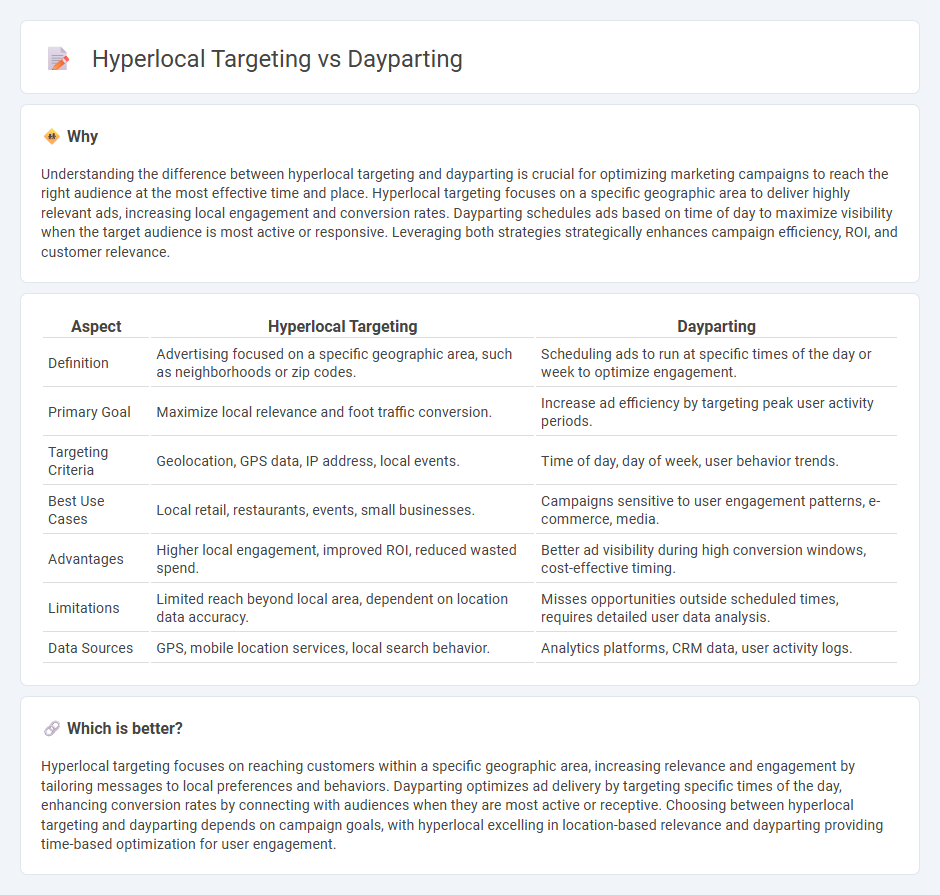
Hyperlocal targeting focuses on reaching audiences within a very specific geographic area, enhancing relevance through location-based personalization and real-time data analysis. Dayparting segments campaigns by time of day, optimizing ad delivery to align with consumer behavior patterns and peak engagement hours. Explore how combining hyperlocal targeting with dayparting can maximize marketing efficiency and boost conversion rates.
Why it is important
Understanding the difference between hyperlocal targeting and dayparting is crucial for optimizing marketing campaigns to reach the right audience at the most effective time and place. Hyperlocal targeting focuses on a specific geographic area to deliver highly relevant ads, increasing local engagement and conversion rates. Dayparting schedules ads based on time of day to maximize visibility when the target audience is most active or responsive. Leveraging both strategies strategically enhances campaign efficiency, ROI, and customer relevance.
Comparison Table
| Aspect | Hyperlocal Targeting | Dayparting |
|---|---|---|
| Definition | Advertising focused on a specific geographic area, such as neighborhoods or zip codes. | Scheduling ads to run at specific times of the day or week to optimize engagement. |
| Primary Goal | Maximize local relevance and foot traffic conversion. | Increase ad efficiency by targeting peak user activity periods. |
| Targeting Criteria | Geolocation, GPS data, IP address, local events. | Time of day, day of week, user behavior trends. |
| Best Use Cases | Local retail, restaurants, events, small businesses. | Campaigns sensitive to user engagement patterns, e-commerce, media. |
| Advantages | Higher local engagement, improved ROI, reduced wasted spend. | Better ad visibility during high conversion windows, cost-effective timing. |
| Limitations | Limited reach beyond local area, dependent on location data accuracy. | Misses opportunities outside scheduled times, requires detailed user data analysis. |
| Data Sources | GPS, mobile location services, local search behavior. | Analytics platforms, CRM data, user activity logs. |
Which is better?
Hyperlocal targeting focuses on reaching customers within a specific geographic area, increasing relevance and engagement by tailoring messages to local preferences and behaviors. Dayparting optimizes ad delivery by targeting specific times of the day, enhancing conversion rates by connecting with audiences when they are most active or receptive. Choosing between hyperlocal targeting and dayparting depends on campaign goals, with hyperlocal excelling in location-based relevance and dayparting providing time-based optimization for user engagement.
Connection
Hyperlocal targeting enhances marketing effectiveness by focusing on specific neighborhoods or communities, allowing brands to deliver highly relevant content based on precise geographic data. Dayparting complements this strategy by scheduling advertisements at optimal times during the day when the target audience is most active and receptive, maximizing engagement and conversion rates. Combining hyperlocal targeting with dayparting enables marketers to tailor messages both spatially and temporally, driving higher ROI in local advertising campaigns.
Key Terms
Time Segmentation
Dayparting focuses on time segmentation by targeting specific hours or parts of the day when audiences are most active, optimizing ad delivery and maximizing engagement during peak periods. Hyperlocal targeting narrows the audience based on geographic location, often combining location with time to boost relevance. Explore how integrating dayparting with hyperlocal strategies enhances precision in marketing campaigns.
Geographic Precision
Dayparting optimizes ad delivery by scheduling campaigns during specific times of the day to capture peak audience engagement, enhancing temporal relevance. Hyperlocal targeting refines geographic precision by focusing on narrowly defined locations, such as neighborhoods or city blocks, ensuring ads reach the most contextually appropriate audience. Explore how integrating these strategies can maximize your marketing effectiveness with advanced geographic insights.
Audience Relevance
Dayparting enhances audience relevance by delivering ads during peak engagement times tailored to user behavior patterns, maximizing impact and conversion rates. Hyperlocal targeting sharpens focus by pinpointing specific geographic areas, enabling highly personalized messaging that responds to local preferences and context. Explore more to understand how combining these strategies can boost marketing effectiveness.
Source and External Links
Dayparting Defined: How to Optimize Your Broadcast Reach - Dayparting in broadcasting divides the day into segments targeting different audiences based on viewing habits, used in TV, radio, and digital channels to tailor content and ads to key demographics during morning, daytime, prime time, and late night periods.
What Is Dayparting? | Digital Marketing Glossary - Dayparting is a digital marketing tactic where advertisers schedule ads to run only during specific times of day to maximize conversions and optimize ad spend by targeting audiences when they are most likely to engage or shop.
Dayparting: What Is Dayparting? - Dayparting in PPC advertising schedules ads for particular times or days to improve targeting efficiency, capitalizing on peak audience activity such as business hours or weekends to increase conversion rates and ad visibility.
 dowidth.com
dowidth.com